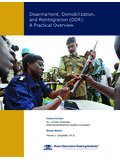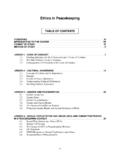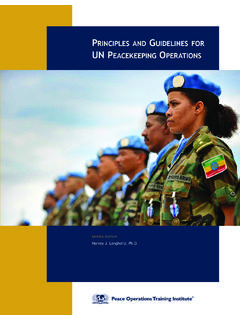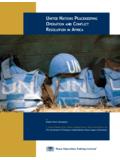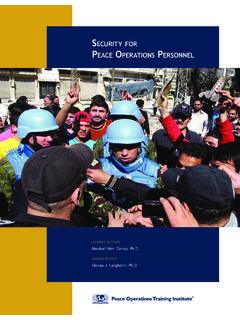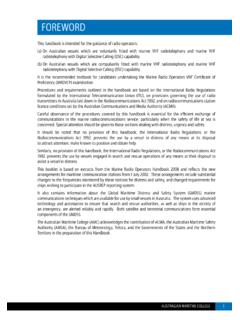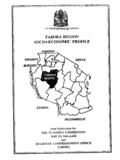Transcription of Introduction to the UN System: Orientation for Serving on ...
1 Peace Operations Training Institute Study peace and humanitarian relief any place, any timeCourse AuthorMr. Julian Harston, Assistant Secretary-General to the United Nations (Retired)series editorHarvey J. Langholtz, to the UN system : Orientation for Serving on a UN Field MissionPeace Operations Training Institute Study peace and humanitarian relief any place, any timeCourse AuthorMr. Julian Harston, Assistant Secretary-General to the United Nations (Retired)series editorHarvey J. Langholtz, to the UN system : Orientation for Serving on a UN Field MissionCover Photo: UN Photo #553835 by Devra Berkowitz. Wide view of the Security Council meeting on women and peace and security.
2 24 June 2013. 2015 Peace Operations Training Institute. All rights Operations Training Institute 1309 Jamestown Road, Suite 202 Williamsburg, VA 23185 USA edition: 2001 by LCOL Christian H rleman Second edition: 2003 Third edition: 2011 Fourth edition: 2015 by Mr. Julian HarstonThe material contained herein does not necessarily reflect the views of the Peace Operations Training Institute (POTI), the Course Author(s), or any United Nations organs or affiliated organizations. The Peace Operations Training Institute is an international not-for-profit NGO registered as a 501(c)(3) with the Internal Revenue Service of the United States of America. The Peace Operations Training Institute is a separate legal entity from the United Nations.
3 Although every effort has been made to verify the contents of this course, the Peace Operations Training Institute and the Course Author(s) disclaim any and all responsibility for facts and opinions contained in the text, which have been assimilated largely from open media and other independent sources. This course was written to be a pedagogical and teaching document, consistent with existing UN policy and doctrine, but this course does not establish or promulgate doctrine. Only officially vetted and approved UN documents may establish or promulgate UN policy or doctrine. Information with diametrically opposing views is sometimes provided on given topics, in order to stimulate scholarly interest, and is in keeping with the norms of pure and free academic pursuit.
4 Versions of this course offered in other languages may differ slightly from the primary English master copy. Translators make every effort to retain the integrity of the OPERATIONS TRAINING INSTITUTET able of ContentsIntroduction to the UN system : Orientation for Serving on a UN Field MissionForeword xMethod of Study xiLesson 1 Framework for a Global Organization, Past and Present 12 Section The Founding of the United Nations and its Charter 14 Section Purposes and Principles of the United Nations 16 Section Legal Framework and Authority 19 Section Financial Principles and Budget of the United Nations 22 Section The United Nations system 23 Section Measurable Global Impact 29 Lesson 2 The Principal Organs of the United Nations 32 Section General Assembly 34 Section Security Council 37 Section Economic and Social Council 40 Section Secretariat and the Secretary-General 43 Section International Court of Justice 47 Section Trusteeship Council 50 Introduction TO THE UN system .
5 Orientation FOR Serving ON A UN FIELD MISSIONPEACE OPERATIONS TRAINING INSTITUTEvILesson 3 The Role of the United Nations in Global Peace and Security 54 Section The Evolving UN Response to Global Conflict 56 Section Mechanisms for Stronger Peace and Security 59 Section The Guiding Principles of Peace Operations 61 Section Multidimensional Components 65 Section Types of Peace Operations 68 Section Planning and Preparation 73 Section Implementation 76 Section Management Responsibilities 78 Section The Peacekeeping Partnership 79 Lesson 4 The Role of the United Nations in Global Development and Humanitarian Action 82 Section The Development Concept 84 Section The Interface Between Disaster Relief and Development 88 Section Humanitarian Imperatives 89 Section Distinctions and Similarities between Human Rights Law and International Humanitarian Law 93 Section Principles of International Humanitarian Law 94 Section Principles of Human Rights 96 Section Human Development and Climate Change 106 Lesson 5 The Dynamic Field Environment 110 Section Social and Cultural Environment 112 Section Mission Environment 116 Section Civil-Military Cooperation (CIMIC) 119 Section Safety and Security Environment 120 Introduction TO THE UN system .
6 Orientation FOR Serving ON A UN FIELD MISSIONPEACE OPERATIONS TRAINING INSTITUTEvIILesson 6 Principles and Responsibilities of UN Field Personnel 126 Section Service for Humanity 128 Section Obligations and Duties 128 Section Cultural and Social Demands 131 Section Personal Demands 133 Section Privileges and Immunities 135 Annex A: Ten Rules Code of Personal Conduct for Blue Helmets 136 Lesson 7 Safety and Security for UN Field Personnel 140 Section Responding to Threats Facing the UN system 142 Section Main Principles and Structure of the UN Security Management system (UNSMS) 143 Section Responsibilities of UN Personnel 148 Section Personal Safety and Precautions 150 Section Travel Precautions 155 Section Sexual Harassment and Sexual Assault 158 Section Special Security Precautions 159 Section First Aid 163 Section Coping with Stress 167 Lesson 8 Strategies and Techniques for Effective Fieldwork 172 Section Participatory Methods 174 Section Projects and Project Control 175 Section Monitoring and Verification 177 Section Transparent Communication 179 Section Negotiation 183 Introduction TO THE UN system .
7 Orientation FOR Serving ON A UN FIELD MISSIONPEACE OPERATIONS TRAINING INSTITUTEvIIIS ection Mediation 185 Section Written Communications and Reports 188 Section Communication with the Media 188 Lesson 9 Global Partners for Development and Peace 194 Section Establishing Organizational Relationships in the Field 196 Section UN Programmes and Funds 197 Section UN Specialized Agencies 202 Section International Organizations with Member States 203 Section Non-Governmental International Organizations 205 Section International Governmental Organizations 207 Section Non-Governmental Organizations 209 Introduction TO THE UN system : Orientation FOR Serving ON A UN FIELD MISSIONPEACE OPERATIONS TRAINING INSTITUTEIxAppendicesAppendix A: List of Acronyms 214 Appendix B: Current Peacekeeping Missions 219 About the Author: Mr.
8 Julian Harston 220 Instructions for the End-of-Course Examination 221 Introduction TO THE UN system : Orientation FOR Serving ON A UN FIELD MISSIONPEACE OPERATIONS TRAINING INSTITUTExWelcome to this course, which will introduce you to the United Nations and its role in international peace and security. I ve been in the business of peace and security and diplomacy most of my working life, and I really don t remember a moment when the world faced such problems as it does today. In order to meet the unique obligations placed on it by the world community, the United Nations needs people, both civilian and military, to work in the field around the world. It needs people, civilian and military, who understand the United Nations its history and its activities, both past and present.
9 Activities which make it a vital part of the process of mitigating and even from time to time solving some of the world s greatest United Nations is not easy. It is a complex organization made up of many different parts which are independent but are expected to work together in the integrated operations which now form the largest part of what we do. What we must do together as you follow this course is equip you with some of the knowledge and background information that you will need in order to become a valuable member of a UN breadth of activities now carried out by integrated missions in the field require not just military and police and the more traditional civilian political and administrative components, but now include civil affairs, humanitarian work, communications, elections, security sector reform, rule of law, gender affairs, and a wide variety of peacebuilding and development activities.
10 When I was Serving in UNTAES, the mission in Eastern Slavonia in the former yugoslavia, I had colleagues who were running the railways, who were running the sewage systems, who were running most of the government in that small place a multitude of activities. The question of whether UN peace operations can take on more has to been seen in the fact that there are so few global alternatives. Of all the world s organizations, the UN is least able to turn its back on people most in need of safety and 2000, the Brahimi Report called on the leaders of the world to renew their commitment to the ideals of the United Nations, to commit as well as to strengthen the capacity of the United Nations to fully accomplish the mission which is, indeed, its very raison d tre: to help communities engulfed in strife and to maintain or restore peace.
